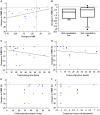Therapeutic Approaches to Nonalcoholic Fatty Liver Disease: Exercise Intervention and Related Mechanisms
- PMID: 30374329
- PMCID: PMC6196235
- DOI: 10.3389/fendo.2018.00588
Therapeutic Approaches to Nonalcoholic Fatty Liver Disease: Exercise Intervention and Related Mechanisms
Abstract
Exercise training ameliorates nonalcoholic fatty liver disease (NAFLD) as well as obesity and metabolic syndrome. Although it is difficult to eliminate the effects of body weight reduction and increased energy expenditure-some pleiotropic effects of exercise training-a number of studies involving either aerobic exercise training or resistance training programs showed ameliorations in NAFLD that are independent of the improvements in obesity and insulin resistance. In vivo studies have identified effects of exercise training on the liver, which may help to explain the "direct" or "independent" effect of exercise training on NAFLD. Exercise training increases peroxisome proliferator-activated receptor gamma coactivator 1-alpha (PGC1α) expression, improves mitochondrial function and leads to reduced hepatic steatosis, inflammation, fibrosis, and tumor genesis. Crosstalk between the liver and adipose tissue, skeletal muscle and the microbiome is also a possible mechanism for the effect of exercise training on NAFLD. Although numerous studies have reported benefits of exercise training on NAFLD, the optimal duration and intensity of exercise for the prevention or treatment of NAFLD have not been established. Maintaining adherence of patients with NAFLD to exercise training regimes is another issue to be resolved. The use of comprehensive analytical approaches to identify biomarkers such as hepatokines that specifically reflect the effect of exercise training on liver functions might help to monitor the effect of exercise on NAFLD, and thereby improve adherence of these patients to exercise training. Exercise training is a robust approach for alleviating the pathogenesis of NAFLD, although further clinical and experimental studies are required.
Keywords: biomarkers; exercise protocol; hepatokines; lifestyle modification; organ crosstalk; training protocol.
Figures



Similar articles
-
Energy-matched moderate and high intensity exercise training improves nonalcoholic fatty liver disease risk independent of changes in body mass or abdominal adiposity - A randomized trial.Metabolism. 2018 Jan;78:128-140. doi: 10.1016/j.metabol.2017.08.012. Epub 2017 Sep 20. Metabolism. 2018. PMID: 28941598 Clinical Trial.
-
Long-term effects of aerobic plus resistance training on the adipokines and neuropeptides in nonalcoholic fatty liver disease obese adolescents.Eur J Gastroenterol Hepatol. 2012 Nov;24(11):1313-24. doi: 10.1097/MEG.0b013e32835793ac. Eur J Gastroenterol Hepatol. 2012. PMID: 22932160 Clinical Trial.
-
Short-term aerobic exercise training improves gut peptide regulation in nonalcoholic fatty liver disease.J Appl Physiol (1985). 2016 May 15;120(10):1159-64. doi: 10.1152/japplphysiol.00693.2015. Epub 2016 Mar 31. J Appl Physiol (1985). 2016. PMID: 27032902 Free PMC article.
-
Microbiome and NAFLD: potential influence of aerobic fitness and lifestyle modification.Physiol Genomics. 2017 Aug 1;49(8):385-399. doi: 10.1152/physiolgenomics.00012.2017. Epub 2017 Jun 9. Physiol Genomics. 2017. PMID: 28600319 Review.
-
Free radical biology for medicine: learning from nonalcoholic fatty liver disease.Free Radic Biol Med. 2013 Dec;65:952-968. doi: 10.1016/j.freeradbiomed.2013.08.174. Epub 2013 Aug 29. Free Radic Biol Med. 2013. PMID: 23994574 Review.
Cited by
-
Vitamin B6 efficacy in the treatment of nonalcoholic fatty liver disease: an open-label, single-arm, single-center trial.J Clin Biochem Nutr. 2021 Mar;68(2):181-186. doi: 10.3164/jcbn.20-142. Epub 2021 Jan 16. J Clin Biochem Nutr. 2021. PMID: 33879971 Free PMC article.
-
Myokines in metabolic homeostasis and diabetes.Diabetologia. 2019 Sep;62(9):1523-1528. doi: 10.1007/s00125-019-4927-9. Epub 2019 Jul 1. Diabetologia. 2019. PMID: 31263909 Review.
-
Effect of aerobic exercise on GRP78 and ATF6 expressions in mice with non-alcoholic fatty liver disease.Sports Med Health Sci. 2022 Nov 22;5(2):112-119. doi: 10.1016/j.smhs.2022.11.002. eCollection 2023 Jun. Sports Med Health Sci. 2022. PMID: 37424531 Free PMC article.
-
Control of inflammatory lung injury and repair by metabolic signaling in endothelial cells.Curr Opin Hematol. 2025 May 1;32(3):157-167. doi: 10.1097/MOH.0000000000000848. Epub 2024 Oct 25. Curr Opin Hematol. 2025. PMID: 39450949 Review.
-
A descriptive cross sectional study comparing barriers and determinants of physical activity of Sri Lankan middle aged and older adults.PLoS One. 2020 May 12;15(5):e0232956. doi: 10.1371/journal.pone.0232956. eCollection 2020. PLoS One. 2020. PMID: 32396547 Free PMC article.
References
-
- Ekelund U, Steene-Johannessen J, Brown WJ, Fagerland MW, Owen N, Powell KE, et al. . Does physical activity attenuate, or even eliminate, the detrimental association of sitting time with mortality? A harmonised meta-analysis of data from more than 1 million men and women. Lancet (2016) 388:1302–10. 10.1016/S0140-6736(16)30370-1 - DOI - PubMed
-
- Kivimäki M, Kuosma E, Ferrie JE, Luukkonen R, Nyberg ST, Alfredsson L, et al. . Overweight, obesity, and risk of cardiometabolic multimorbidity: pooled analysis of individual-level data for 120813 adults from 16 cohort studies from the USA and Europe. Lancet Public Health (2017) 2:e277–85. 10.1016/S2468-2667(17)30074-9 - DOI - PMC - PubMed
Publication types
LinkOut - more resources
Full Text Sources

